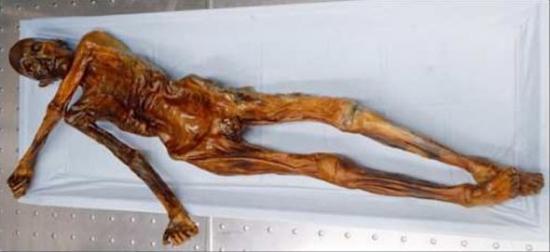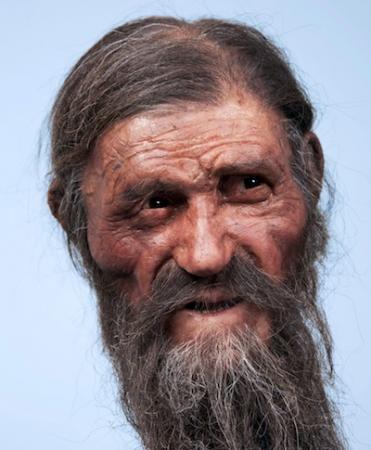北京时间8月26日消息,1991年,登山者在阿尔卑斯山冰川中意外发现了一具因冰封而保存完好的天然木乃伊,即著名的“冰人奥茨”。意大利木乃伊和冰人研究所考古学家近日通过对奥茨的腹部进行扫描分析后取得最新发现,奥茨是在吃完一顿大餐之后被伏兵所杀,而并非是此前所认为的他是因为饥饿而导致筋疲力尽最后被敌人杀死。最新研究成果让“冰人奥茨”的死亡谜团又成为当前考古学界讨论的热点话题。

“冰人奥茨”发现于1991年。据考古学家推断,奥茨应该死于5300年前。根据他的纹身和工具等原始素材,艺术家们再为他添上了一双充满感情的眼睛和一张饱经风霜的脸,艺术再现了“冰人奥茨”的鲜活面容。奥茨迅速成为铜器时代的一位名人。关于奥茨的生活环境以及他的死亡原因,一直是公众和考古学家们苦思而不得其解的谜团之一。

最初,奥茨被认为可能是因为被暴风雪阻隔于山腹中而冻死,另一种死亡原因可能是作为宗教仪式的祭品。但是在2001年,研究人员在他的左肩部发现了一个箭头,他的手部和胸部都有擦伤和切口,头部有被钝器击打过的痕迹。很明显,奥茨是一场不公平对抗中的牺牲品。
此外,在奥茨的身上还发现了当地特有的花粉粒。结合对花粉粒的检验结果,关于奥茨死亡前最后时刻的可能情形显现出来。他可能在一次袭击活动中与部族走散并迷路了,后来又被对手追赶跑到山中。杀死了两名追击者后,奥茨带伤背着一位受伤的同伴继续逃亡。连日来的逃亡让奥茨根本没有时间吃饭。腹中空空的奥茨最终筋疲力尽,被对手抓获并处死。
然而,意大利木乃伊和冰人研究所考古学家们近日取得的最新发现表明,奥茨腹中并不是空的。这项研究由木乃伊和冰人研究所考古学家艾伯特-辛科领导实施。研究人员利用CT扫描仪再一次对奥茨的木乃伊进行了分析研究,他们发现此前被认为是奥茨大肠的一部分器官其实是他的胃部。奥茨死后,其胃部萎缩并发生位置转移。
在奥茨大肠的其他部分,他死亡前数天所吃掉的食物仍然存在,考古学家已经在其中发现了马鹿、野生山羊和谷物的痕迹。关于奥茨的胃部,辛科等人仍在努力分析其中的内容。但不管其中有什么,奥茨的最后一顿饭肯定是一顿大餐。这一发现与奥茨在一场冲突后被追杀致死的说法无法吻合。
辛科解释说,“在被苦苦追杀的巨大压力下,奥茨不可能有机会去享用大餐。更可能的情况是,在艰难地爬到山上后,他认为自己所处的环境足够安全,可以好好休息一下,然后吃一顿大餐。吃完之后,他刚刚离开自己休息之处不远,就被身后的伏兵突然击毙。”
辛科等人的研究成果发表于《考古科学期刊》(Journal of Archaeological Science )上。当然,这一研究成果也并没有给奥茨的死亡过程和死亡原因作出最后结论。
生物探索推荐英文论文摘要:
New radiological insights into the life and death of the Tyrolean Iceman
Abstract
The radiological examinations carried out on the Tyrolean Iceman (5300 B.P.) in Bolzano between 2001 and 2006 have undergone a new, systematic re-appraisal, during which new findings have been added to those already known beforehand. Until now, it has been assumed that the Iceman’s stomach was empty (due to the fact that this organ could not be localised), the colon contents constituting the Iceman’s last meal. During this re-appraisal, however, the stomach could not only be exactly identified, but was also found to be well-filled, shedding new light on the scenario leading to his violent death. In addition, several other novel aspects were observed: three gallbladder stones were found which, in combination with the previously identified atherosclerosis, indicate that the Iceman’s diet may have been richer in animal products than previous studies have suggested. The signs of enthesopathy in the knees indicate that he spent many hours wandering in the mountains. Several radio-opaque objects superficially embedded within the soft tissue were identified as being of taphonomic origin. The right humerus was found to be postmortally fractured.
相关推荐:







